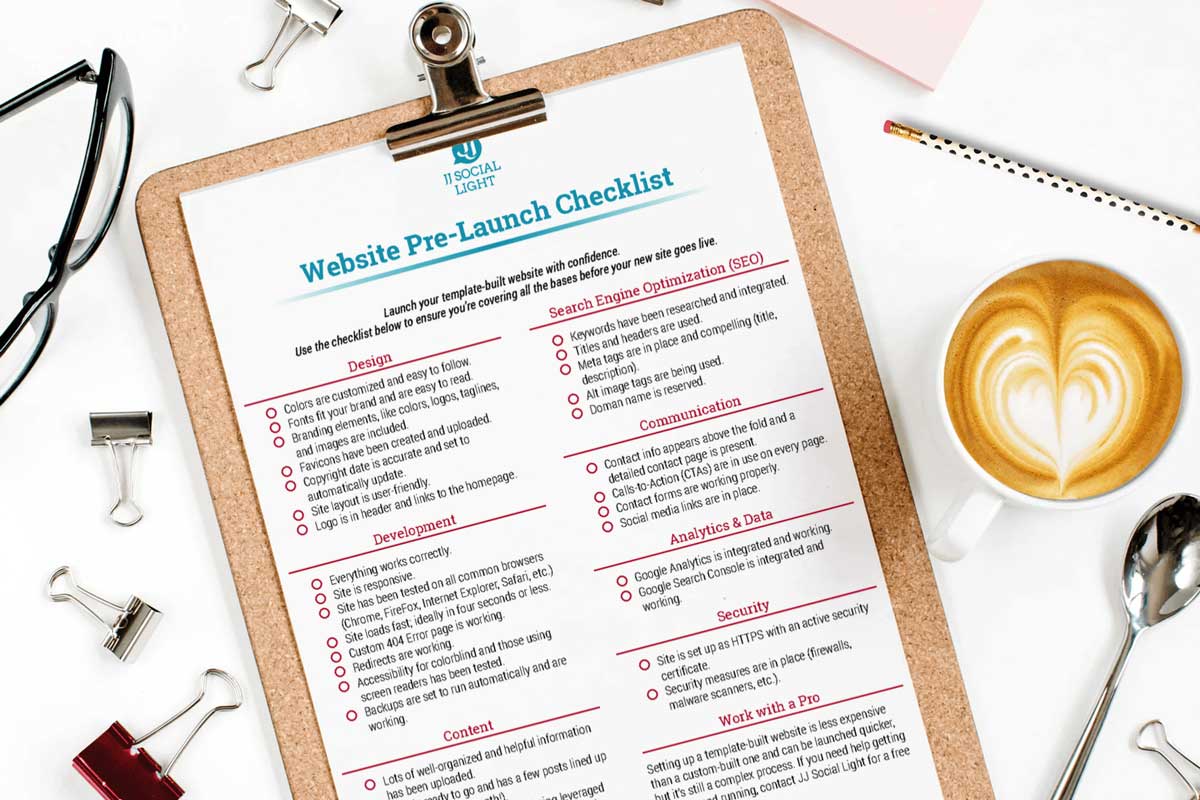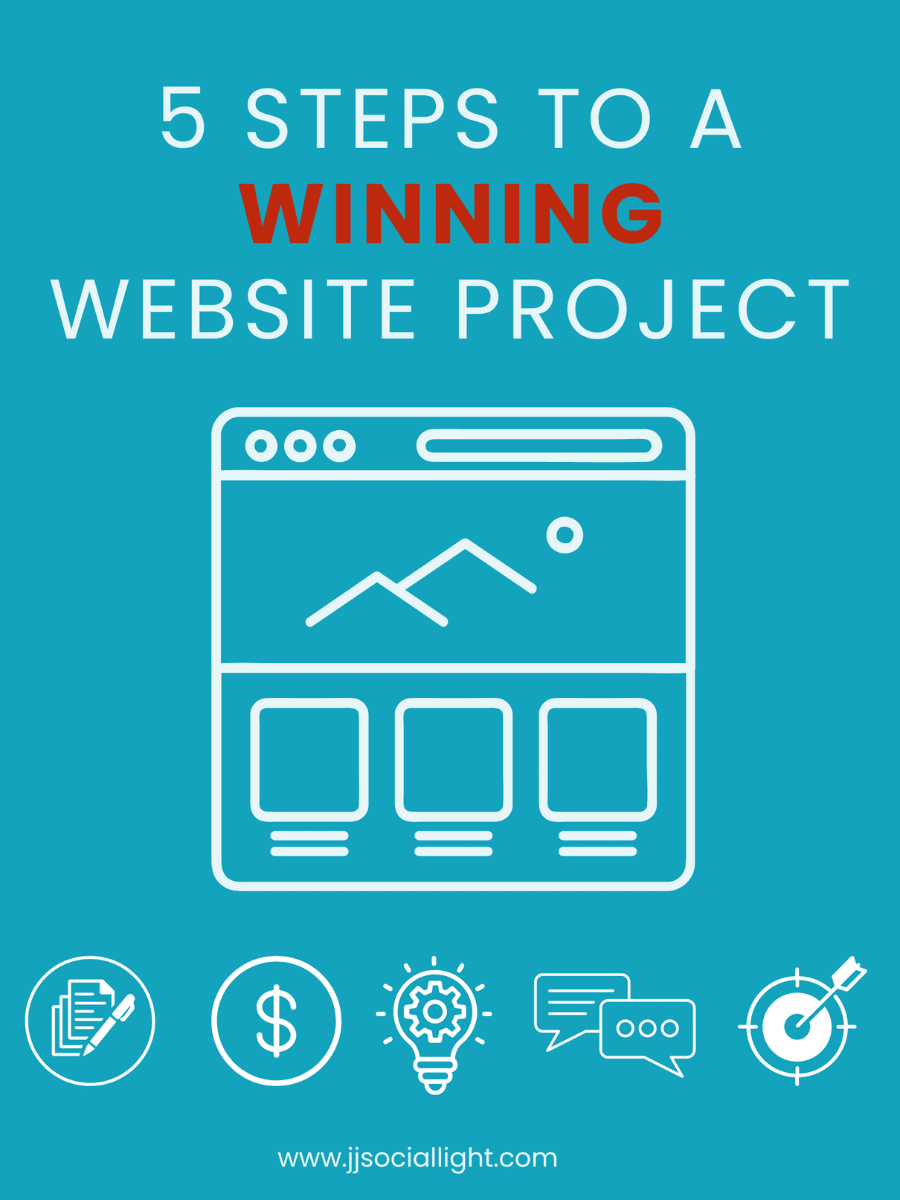Design
Before digging into “design,” it’s important to make the distinction between design and development. Your website designer and developer may be the same or different people, but the skills applied and the goals are different. Design includes the visual aspects of the site and its general flow.
❑ Are you using the ideal custom colors?
Naturally, you’ll want colors that represent your brand well and convey the message you want to send visitors and the emotions you’d like to evoke. Template-built websites usually offer a couple of default color themes to select from, but don’t limit yourself to only the choices presented. Your developer can change up the colors to match the ones your company is already using elsewhere to give a cohesive experience.
It’s also worth noting that not everyone sees colors the same way. You will have site visitors who are color blind or have varying levels of vision impairment. For this reason, it’s best to work with high-contrast colors and avoid using red/ green and blue/ yellow combinations to distinguish menu options or buttons.
❑ Have you examined your fonts?
Like colors, your template-built website should already have fonts that work well. However, even the fonts say something about the personality of your brand. For example, fonts with straight lines and hard edges can demonstrate ethics and attention to detail, while more curvaceous fonts can signify friendliness and creativity. If you go too far out with decorative fonts, it’s harder for people to read and some browsers may not even try to use your stylistic choices, so always work with fonts that are universal, easy to read, and “feel” right for your message. If your default font doesn’t work right for your needs, change it up.
❑ Did you incorporate branding elements?
Colors and fonts are part of your branding and the ones used on your site should be a match for what you’re using elsewhere, or at least as close to it as you can get. However, you’ll also want to doublecheck that you’ve got things like logos taglines, and branded images throughout.
❑ Have favicons been created and uploaded?
A favicon is the image that appears in a browser tab and other places, such as favorites menus or suggested sites. They tend to be very small, so repurposing a logo doesn’t always work well. Have one professionally designed to ensure it creates a good first impression, is memorable, suits your company, and is easily recognized.
❑ Is the copyright date current and programmed to automatically adjust?
Some people believe that having a current copyright date on the site impacts how well it ranks in search engines. This remains to be proven, but an out-of-date copyright date certainly sends a signal to your human readers that your site may not be well-maintained or could have outdated information. Before you go live, make sure your site is stamped with a current copyright date and check with your developer that it has been programmed to update automatically each year. Failing this, put a reminder in your phone to update it when the year rolls over.
❑ Is the site easy to use?
Most template-built websites have already undergone usability testing by a wide variety of users, but it’s still a good idea to make sure that menus, links, and other interactive features are placed in a way that suits a person’s natural flow as they browse the site.
❑ Do you have a logo in the header that links to the homepage?
This is such a common feature on websites that people expect to find it. If your site doesn’t have a logo in the header that links to the homepage, people will still try to click on the image, but will genuinely become confused when nothing happens. Although they’ll change course quickly and search for a link to the homepage, the disconnect will be enough to harm the flow and diminish the experience. Thankfully, it's a very easy thing to code in.
Development
Website development is typically the things visitors to the site don’t see, like the raw backend coding and functionality.
❑ Does everything work correctly?
Spend some time browsing the site and interacting with the various links and features on each page to make sure everything is functioning as it should be.
❑ Is it responsive?
A responsive site naturally adapts itself to the screen it’s being viewed on. That way, visitors get a great experience whether they’re viewing the site on a massive desktop, smaller laptop, tablet, or cell phone. In the not-too-distant past, Google realized that about 60% of all searches were being performed on mobile devices, so the search engine now indexes the mobile version of a website first, ensuring that the majority of people will be directed to sites designed for them. This means your site must be responsive for the sake of your visitors and to rank well in search engines.
❑ Does it look and operate well on all common browsers?
Cross-browser compatibility is a big deal because each browser reads the coding of your site a bit differently. At a bare minimum, you’ll want to check it across all major browsers, including Chrome, FireFox, Explorer/ Edge, and Safari.
❑ Does it load fast?
About a quarter of visitors will leave your site if it doesn’t load within four seconds. Abandonment rates climb the longer people wait. Run some tests to see how quickly your site loads and have your developer finetune things if it’s sluggish.
❑ Was a custom 404 page set up?
When people try to access a page that doesn’t exist, they get a 404 Error page instead. Template-built sites typically have a generic 404 page, but it’s still a good idea to check to see if yours is working. It’s also a good idea to customize yours and offer up links you think might be helpful or maybe even a friendly note.
❑ Are all other redirects working properly?
Particularly if you’re rebuilding a website, you want to ensure that the old links still send people to the places they need to go.
❑ Has it been accessibility tested?
Make sure those who are color blind or using screen readers can use the site with ease.
❑ Are backups set to run automatically?
Don’t assume your site is backed up somewhere. Hopefully, you’ll never need to use a backup, but if the unthinkable happens, you don’t want to discover your data is completely gone.
Content
People say, “content is king,” and in a way, it is. It’s the content of your site that draws people in and determines your rank in search engines.
❑ Is your site full of well-organized and helpful information?
At a bare minimum, you’ll need static pages which layout your offerings and how you operate. Make sure information is grouped by topic in a logical manner.
❑ Do you have an active blog?
Blogs that share helpful information related to your industry or services you offer attract visitors who ultimately become your customers. Plus, the more blogs you have, the more pages Google and other search engines have to index, so your website will appear in more searches and rank closer to the top. In fact, research conducted by HubSpot shows that sites with 16 or more fresh blog posts per month earn 3.5-times more traffic than those with 4 or fewer.
❑ Are you including multiple forms of content?
Many people equate written words with content, and while the words you pen are indeed content, it’s important to diversify. Images and infographics, for example, are easy to digest and attract attention. Short video clips get a lot of social media shares. Even podcasts and similar may have a place in your overall content strategy, depending on what resonates with your audience. Experiment with the various forms to see what works.
❑ Have you run a spelling and grammar check?
Even minor errors can diminish the message of make your business look unprofessional, so use spelling and grammar tools to check all the content on the site and have another set of human eyes give it a once-over before going live.
❑ Are all links working properly?
Take a few moments to check through all the links or use a program to check them for you. If there are any dead or incorrect ones, swap them out to improve the usability and search engine friendliness of the site.
❑ Do you have all legally required pages?
Generally speaking, you’ll need a Terms of Service page and Privacy page which outlines how you’ll use any data you collect. However, certain industries and jurisdictions have additional legal requirements, so verify which types of disclosures are appropriate for your business before going live.
Search Engine Optimization (SEO)
Search engines look for marks of quality and user friendliness when they’re determining which sites show up in searches and in what order they appear in. Following a few best practices will help ensure you get more organic traffic.
❑ Did you implement a keyword strategy?
You can help your site appear in more searches and rank higher by optimizing pages for phrases people are already typing into Google. If you aren’t sure how keywords work or don’t have the expertise necessary to select them, bring on a pro to reap the benefits of unpaid traffic.
❑ Are you leveraging title tags and headers?
The best way to organize content on a page is to establish a hierarchy with the use of title and heading tags. For maximum SEO benefit, your keywords should be included in these when it makes sense to do so as well.
❑ Does each page have compelling meta tags?
Meta tags, more specifically title and description tags, tell search engines what your page is about. When you run a search for something and read the results page, it’s the title and description tags you’re usually reading. If you don’t have them in place, search engines will pull content off the page instead, which doesn’t always give the best first impression. Pen yours in a way that adequately outlines what people will find, leverages keywords, and includes a call-to-action in the description.
❑ Are you using alt image tags?
A lot of what Google and other search engines look for are markers of a good user experience. That means ensuring everyone can access your site with ease. Alt image tags are one component of this. They give visually impaired people using screen readers a verbal description of images.
❑ Is your domain name solid and reserved?
Purchasing a domain name is often one of the first steps people take when setting up a website, but it’s worthwhile to spend some time reviewing your choice before going live. Make sure it’s short and memorable.
Communication
It’s easy to forget that websites aren’t merely one-way message boards. However, the best-performing ones include lots of ways for people to interact with your business and offer ample opportunity for them to communicate with the business as well.
❑ Is the contact info easy to find?
Options to reach your business should be located “above the fold,” which means they can see it without having to scroll down the page. To encourage phone calls, post your phone number at the very top of the page and add a link for contact info in a prominent area, such as the main menu. On the dedicated contact page, include:
- Phone number
- Address
- Email address
- Map and Directions
- Contact form
❑ Are you using CTAs throughout?
Each page should have at least one call-to-action (CTA) that guides the visitor through the next steps. A few examples include:
- Schedule a consultation
- Get a quote
- Sign up for the newsletter
- Download a whitepaper, guide, or other helpful resources
- Gain access to members-only resources
- Register for an event
❑ Did you doublecheck the contact forms?
You should have a variety of contact forms throughout the site. Do a test run on each one to make sure nothing odd happens when trying to submit the form and that the details arrive in your inbox as expected.
❑ Are social media links in place?
The more often people connect with your company, the more likely they are to become loyal customers and refer to others. Encouraging people to like and follow you on social media platform makes this much easier, plus can serve as a form of “social proof” that you’re a reputable business, so new customers have more confidence and are more willing to take action.
Analytics & Data
The more you learn about how your site functions and the people who visit it, the easier it is to enhance their experience, thus increasing traffic, satisfaction, and conversions. Thankfully, Google offers some free tools that will help you collect data and analyze it.
❑ Did you install Google Analytics?
Google Analytics collects data about the people who use your site and how they use it. In short, you add a small snippet of code to the back end of your site and it starts tracking things in the background. You can use it to learn:
- How people are finding your site
- How many people are visiting
- Where your visitors come from
- What people are doing while they visit
- Which pages are most popular
❑ Are you using Google Search Console?
Whereas Google Analytics is geared toward the people, Search Console is more about driving traffic to the site. You can use it to learn:
- Which keywords are bringing people to your site
- Which sites are linking to your site
- Which pages of your site have been crawled and indexed
- How your mobile site is performing
Security
In order to protect your site and any data exchanges between you and your visitors, you’ll need to have security measures in place.
❑ Are you set up as HTTPS?
In short, having HTTPS instead of HTTP as part of your domain name means that any data sent between your site and the people using it is encrypted before being sent and decrypted upon arrival. You’ll need to work with your web host to set this up or talk with your developer to see if it’s already been done. Sites that aren’t secured in this way can give off false security alerts, which can be upsetting to visitors, but they can also pose real security risks, so It’s wise to add the extra layer of security.
❑ Do you have security?
Firewalls, malware scanners, and other forms of protection are essential. Unfortunately, millions of sites get nailed by hackers, who may either steal your data, take over your site, or add content you don’t want to it. Obviously, that’s bad for visitors, your reputation, SEO, and business in general. Make sure there are security applications in place, delete all unused profiles, and create a strong password for your admin login. Set a reminder to go back in and change it on a regular basis, as bots can be clever and continuously try to gain entry with guesses. If your password changes, it’s much harder for these programs to gain entry.
Work with a Pro
Setting up a template-built website is less expensive than a custom-built one and can be launched quicker, but it’s still a complex process. If you need help getting yours up and running, contact JJ Social Light for a free consultation.









0 Comments